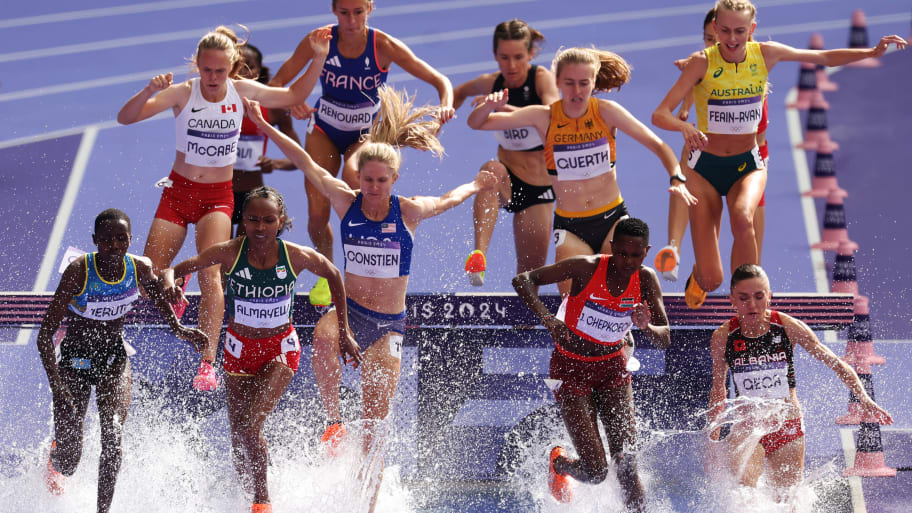
PARIS – As one of America’s steeplechase savants, a nine-time All-American and Rio Olympics competitor, Colleen Quigley understands the calculus. Many find her chosen track and field discipline a little … strange, if, that is, they’ve heard of it at all.
Happens all the time. The questions. The quizzical brows. The lightbulb moments. And the range of expressions, from bemusement to wonder to the shaking of heads. She’ll often get in an Uber, and the driver will ask if she’s an athlete. Yes. Sometimes she says no to end the conversation. If not, they’ll ask about the sport. Her answers range from “track and field” to “a field athlete” to the one that’s certain to provoke more questions. I compete in steeplechase.
When they don’t know, she’ll explain: it’s a race, it’s long and there’s a lot of running. And while running, there are barriers to surmount, and those barriers aren’t like normal hurdles. There are water pits to navigate. Competitors fall regularly—and often spectacularly.
“You have to be some sort of stupid to try and do this thing at all,” she says.
She laughs, then, when one of track’s most popular debates begins. What’s the hardest event? Many say the 800-meter run, because it’s a nearly full sprint for two laps around a track. Some say the 1,500-meters, because it’s the same thing, but not as close to full speed throughout and yet also twice as long. Quigley would like to add steeplechase to the debate. But perhaps it shouldn’t be an argument at all.
Her sport requires elite endurance, for all those meters that must be run. Competitors must be athletic, to go over the barriers; physically tough, to withstand inevitable pain; mentally fortified, to focus while still doing everything else. Otherwise, they’ll land in photographs that live forever: bodies upside down, heads about to hit both water and track.
This race is one of track’s most unpredictable, most strategic and least understood. For fans of Olympic competition, extreme sport enthusiasts or anyone who simply loves watching anything crash, steeplechase is the sport for you. It’s time to Embrace the Chase, where track meets distance running meets pile-ups in car accidents meets Game of Thrones-level masochism.
First, to properly embrace, understand the basics: 3,000 meters to run, five barriers to get over and the water pit to survive. The running unfolds on seven-and-1/2 laps on the track. Athletes must go over all barriers; failure on any one means automatic disqualification. On lap 1, competitors skip the water and the first barrier, which is wider than the others, owing to the propensity of participants to stay bunched together early into races. (Imagine leaping over one while next to other racers, all wearing track spikes.) After lap 1, no obstacles are skipped, which adds up to seven water leaps and 28 barriers to jump over.
The pit runs 12 feet near the end of the track—its width: nearly 2.3 feet; its depth: 28 inches, at the deepest point—where it curves before the backstretch. They’re located either inside Lane 1 or outside the last lane (often 8 or 9). There’s a hurdle in front of the pit, although calling that monstrosity a “hurdle” fails to capture its essence. Think: a hurdle that’s more sturdy, that won’t fall if anyone collides with it, and that’s wider than more “normal” versions. That bad boy stretches 12 feet in width.

There’s strategy, for sure, especially around the water pits. Competitors most often step up, on top of the barrier, then leap as far as they can. Without full running momentum, though, they don’t usually clear the water pit. The general rule for an ideal sequence of steps ends with one foot in the water and the other out. Those who rely more on momentum jump over the barrier and stride through the water, which means they get far more than wet.
With so many other competitors, everything—and everyone—gets wetter and wetter as the race unspools. This turns steeplechase into something more like Wipeout. Maybe an athlete slips on a barrier. Maybe they land off-balance. Maybe they somersault forward. Maybe they land—on one foot, body bent at a horizontal angle or, in the worst case, headfirst. Maybe the temperatures are lower that day, making the water seeping through their shoes and socks less of an annoyance and more of a menace. Maybe their shoes slip and slide. They still must continue running and surmounting.
Let’s run through the typical arguments against this remarkable event.
Argument 1: There’s no history. Wrong! This event is old. It originated in the U.K., where runners bent on challenging themselves raced from one town’s church steeple to the next, while navigating stone walls and small rivers. These races also borrowed from equestrian, where competitors raced horses through country sides, over hedges.
The modern version originated at Oxford University in the middle of the 19th century and the running distance changed several times in the early 20th century Olympic Games: 2,500 meters and 4,000 meters in Paris, 1900; 2,590 in St. Louis, 1904; 3,200 in London, 1908. By 1920, the course was standardized: 3,000 meters, five barriers—36 inches high for men, 30 inches for women—and the water pit. (In comparison, for track’s Olympic hurdling events, the height of the hurdles ranges from 30 inches (women, 400 meters) to 33 (women, 100 meters) to 36 (men, 400-meters) to 42 (men, 110-meters.) Officials added women’s Olympic steeplechase to the track program in 2008.
Argument 2: there are no scandals, lessening suspense. Wrong again! The Olympic history of steeplechase is laden with doping violations. Remember, this thing is difficult to do.
Argument 3: There aren’t any truly elite athletes. Wrong! The Kenyans crush the steeplechase. One male competitor from Kenya has won gold at the last eight Olympic Games, despite a late entry into the discipline. The country swept the event’s podium in ‘92 and 2004. Two Michael Jordans of steeple lore—Kenya’s Ezekiel Kemboi and Finland’s Volmari Iso-Hollo—won gold, twice. Mahiedine Mekhissi-Benabbad, a retired French champion won three medals (silver in ’08, ’12; bronze, ’16). The women’s competition, with its more limited history, already features four Kenyan medalists (out of 12 total medals).
There aren’t many children who grow up dreaming of steeplechase Olympic glory, if there are any at all. Courtney Wayment finished second at the U.S. Olympic trials in June and will compete in Paris. Her father competed in steeplechase in the 1980s and made two All American teams in college, but he never pushed her into steeple. She played soccer, took up running, became an 800-meter specialist and then landed in the steeplechase by choice.
Quigley danced and played soccer growing up, became an elite runner and came to know steeplechase when her brother began competing in it. Even then she asked, “What’s this?” She’d never heard of steeplechase before. She never considered joining him, not until a coach at Florida State saw her run and told Quigley that, if she did, the Seminoles would offer a full scholarship. She won a national title, steepled at the Olympics, then transitioned to triathlon.
Kenneth Rooks went from a multi-sport athlete to … the steeplechaser who fell down at the USATF outdoor championships in 2023, got up and won the damn thing. He triumphed at U.S. Trials and will compete here. Asked what does connect all the types of athletes who end up in steeple, he says aerobic strength, dexterity and general athleticism, along with the mental fortitude to do this thing that taxes both body and mind.
Chari Hawkins, who will compete in Paris in the heptathlon, decided against becoming a steeplechaser. She loves combined events, but prefers the lighter hurdles—the ones that fall, rather than the ones that cause falls.
“The difference between a barrier and a hurdle is like the difference between a rubber band and a brick wall,” she says. “You hit a hurdle, it topples over. I have scars on my trail leg from hitting [regular] hurdles. So many bloody legs. If I were to hit a barrier, one time, my knee would be gone.”
“I definitely think there’s a level of crazy, for sure,” says Wayment. “It also takes a certain level of athleticism.”
Due to the variance in backgrounds and the nature of the sport, strategy assumes paramount importance. Some competitors are better runners; others, better at getting over barriers. Some possess dizzying kicks down back stretches, while others favor consistency throughout.
Quigley points to Emma Coburn, America’s biggest steeplechase star—a 10-time national title winner, world champion and silver medalist and three-time Olympian and bronze medalist. Quigley isn’t intending disrespect when she says that Coburn, an elite athlete, isn’t an Olympic-caliber one in anything but steeplechase. She wouldn’t likely qualify in running and certainly wouldn’t qualify in hurdles. But she’s built, through a distinct combination of skills, for this specific event. In contrast, Quigley cites Krissy Gear, an American steeplechaser with “the most insane kick of anyone I’ve ever seen in my life.” Wayment points to hurdling skills as her advantage. Rooks considers himself a “running specialist.”
“We’re all kind of weird, in our own special way,” Rooks says.
The steeplechase is every Olympic ideal built into one discipline. It’s combined events. It’s human suffering. It takes more than one type of athleticism. The different factors combine to add thrill and suspense to almost every race.
“It is more visible in the steeplechase with the physical barriers on the track, but the Olympic ideal is involved in every sport and event,” Rooks says. “The steeplechase just shows that in a more visible way.”
That’s why anyone who loves sports, the human spirit or good TV should jump in and Embrace the Chase.
This article was originally published on www.si.com as It’s Time to Embrace the Steeplechase, Track’s Most Unpredictable and Misunderstood Event.







